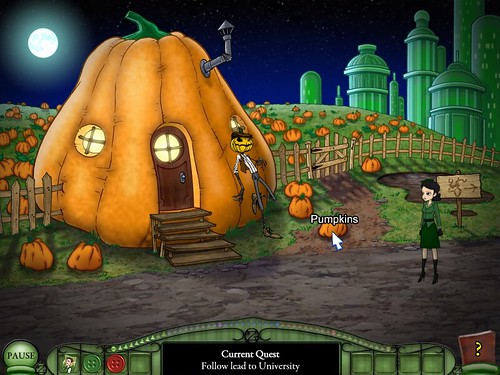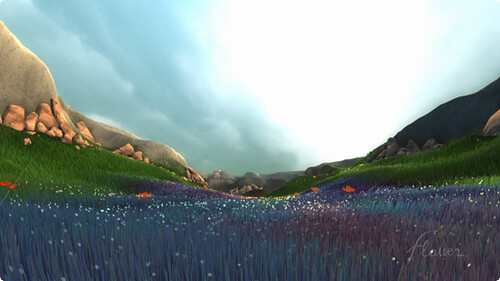Posts from ‘Casual’ Category
Brass Restoration
By: Xander
On: March 22nd, 2009
Okay, probably not what you were expecting to see, but hear me out.
Brass Restoration is a Visual Novel by Japanese based Twincle Drop and translated by Yandere Translations. Unlike a lot of Visual Novels however this was released as a free game, so the translation installer actually includes the full game in its entirety.
The story surrounds a young musician who suffers a cruel accident that robs him of his arm. This leaves you making the occasional choice which slowly affect his life after the accident. Will he be able to mend the connection he had with music now that he can’t create as he used to, or will he instead forge new relationships as a result?
You’ve already left haven’t you? Bugger…
Well if you are still reading, here’s why you should care.
Though it is a free title the art and music aren’t actually that bad. They aren’t as accomplished as maybe Tsukihime or others of its genre but it would be cruel to expect that. What it does have as a well written (and well translated) story, which exemplifies both the bitter-sweet drama and ridiculous humour that this media is famous for. When a choice between a “Good morning kiss” and a “Good morning forehead crusher” (which is every bit as painful as it sounds) is present in a game, even the most cynical critics of the genre must surely crack a wry smile.
It isn’t the greatest game of its kind, but its a free title which really gives the player a crash course in what this style of game is all about. And at only 50MB you could do far worse than give it a go. If you don’t enjoy it then at least you’ve tried something new, and if you do then it only really gets better from here.
GUBS
By: Alehkhs
On: March 4th, 2009
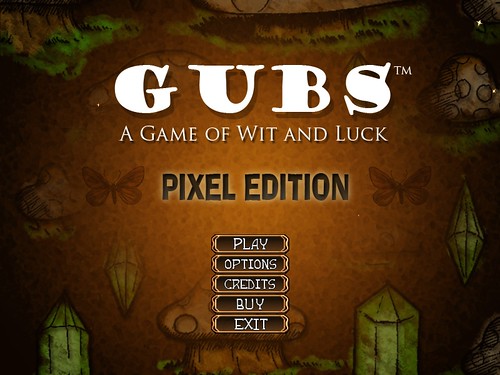
If you are looking for a computer game that is indie to the core, look no farther than “”http://gubcards.com">GUBS: Pixel Edition."
What makes this an indie-game of indie-games is the past of the project. “GUBS” started around 1992 as a series of doodles in the margins of a child’s homework. That child, a young Cole Medeiros,  went on to make a home-made deck of cards created with pencil on squares of index-card. The cards depicted small creatures that would take the title ‘Gubs,’ and other cards depicted the world of these creatures.
went on to make a home-made deck of cards created with pencil on squares of index-card. The cards depicted small creatures that would take the title ‘Gubs,’ and other cards depicted the world of these creatures.
Through the game that took shape over the following years, with cards being added and scraped, a story began to take shape, of Gubs and the timeless wars fought between them. With each new version, Cole would play GUBS with his brother Alex and their friends, trying to find a balanced game.
As the years passed and the game developed, Cole looked into printing a professional deck of his cards. After years of trying different processes and even sending sample decks to publishing companies, Medeiros decided to self-publish the game, and in 2007, the “GUBS: A Game of Wit and Luck” went on sale as a finished project.
Of course, this is a site for “computer” games, and so the story obviously does not end there.
In 2008, Medeiros’ close friend, Matthew Griffin, one of the developers behind the game “Wanderlust: Rebirth,” began the process of developing “GUBS: Pixel Edition.” Simply a single, 7MB executable, “GUBS:PE” contains an impressive amount of polish, containing all of the official art-work from the card-game, as well as a very intuitive interface. Cards are drawn and played with a smooth “click/drag” system. Players of “GUBS:PE” are pitted against two very-competent computer-controlled players (with two levels of difficulty), and within a few quick games, even the most-unfamiliar player to the card-game world will understand the rules. What they may not understand however, is the true depth and complexity of the game.
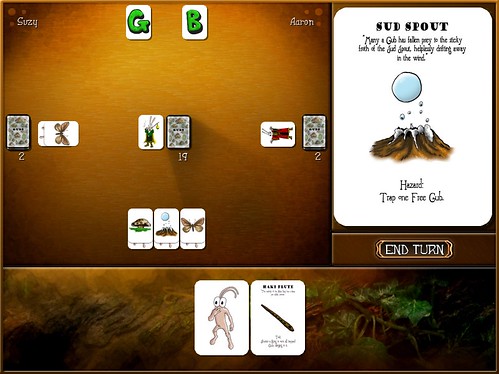
GUBS’ plays like how I would imagine a cross between card games like “Magic: The Gathering” and “UNO” would play. Each player plays and protects their cards while at the same time attempting to steal or discard their opponents’ cards. Yet, GUBS is not a card-collecting game. Each game is played entirely out of one 72-card deck, evening the playing field as far as “who has what” is concerned.
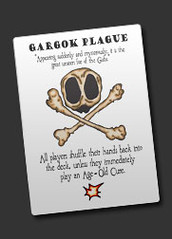 The rules of GUBS are fairly simple, whoever has the most free or “barricaded” Gubs on the table at the end of the game, wins. However, it is GUBS’ very concept of “end of game” makes each round excitingly frantic: within the deck, there are three “letter” cards, which together spell out “GUB.” When the title is complete on the table, the game is done, and scoring takes place.
The rules of GUBS are fairly simple, whoever has the most free or “barricaded” Gubs on the table at the end of the game, wins. However, it is GUBS’ very concept of “end of game” makes each round excitingly frantic: within the deck, there are three “letter” cards, which together spell out “GUB.” When the title is complete on the table, the game is done, and scoring takes place.
Until the three letter cards are drawn, players fight to not only protect their own Gubs, but to steal, trap, or kill those of their opponents. As each player takes their turns, they can draw new cards and play or discard those they already have. “Lure” cards allow you to take Gubs from another player’s hand. Various “Barricade” cards can be placed over Gubs on the table, protecting them to an extent, but even these barriers can be overcome with certain cards. Natural disasters, monstrous creatures, espionage, traps; all these fates can be set against your Gubs. A player might go from having the best hand to having nothing at all in a single draw of the deck. Better yet (and inducing even more paranoia), each player can keep up to 8 cards off the table and hidden from their opponents’ view. Remember though, if a Gub is not on the table (or trapped) at the end of the game, then it counts for nothing.
GUBS:PE is also perhaps the most unique “share-ware” I’ve ever seen. I say this because while GUBS:PE is entirely free to download and play, and if you are content with the computer-controlled opponents (which are very competent at crushing you game after game),then you will be content simply with GUBS:PE. However, there is a “Buy” button on the main menu, and if you are interested in playing against friends, then this is for you. The button leads not to a purchase form for GUBS:PE though, but rather, allows you to purchase an actual GUBS deck.

Concerning the physical deck you will receive should you wish to play GUBS with friends, it is just as polished and colorfully illustrated as the ‘Pixel Edition’ would have you believe. In fact, there are several alternate images for some of the more common cards, and seeing these new illustrations was a pleasant surprise. The cards themselves are of good quality as well, and I was quite satisfied with the overall experience, from GUBS:PE to having a deck to play with against my friends and family.
Truly, it has been awhile since I have been so addicted to such a casual game, let alone a card-game, and I find myself wondering why this doesn’t just come as a default on my computer, right next to Solitaire and Minesweeper.
BeeWare
By: Derek Yu
On: March 3rd, 2009
The website of the 2BeeGames competition takes a slight dig at the IGF by saying “unlike some events where every judge plays only a few games, our judges will play each and every game to determine the finalists (up to 10).” However, developers that are interested in the compo should be more mindful of this part of the official rules:
It goes on to say that the “Contest Entities” do not waive any “rights to use similar or related ideas without any restriction whatsoever.” In other words, if you enter the competition (just enter, not necessarily win), you are giving the casual games publisher Zoo Games a license to not only market and sell your game all over the world, but also make knock-off games using your ideas.
Classy stuff!
(Thanks to the various folks that pointed this out.)
Emerald City Confidential
By: Derek Yu
On: February 25th, 2009
Emerald City Confidential is a new point-and-click adventure game from Dave Gilbert, creator of The Shivah and the Blackwell series. I’m a big fan of The Shivah, which is notable for starring a conflicted rabbi, but earns my respect as a very well-written, humanistic, and entertaining game. So it’s with some disappointment that Emerald City Confidential is perceptibly marred for me by what I can only describe as “casualitis.”
Warning, I’m going to go on a serious tangent by the end of this post.
The game takes place in the world of Oz. You play Petra, a tough, no-nonsense private eye living in the Emerald City, looking to make some emeralds and right some wrongs in the process. Since the classic 1939 film, there have been quite a few other successful adaptations of L. Frank Baum’s fantasy world (which is now in the public domain): off the top of my head, I can think of Return to Oz, Disney’s dark semi-sequel, Wicked, the popular musical, and The Wizard of Oz 3: Dorothy Goes to Hell, a lowbrow animated movie by James “Angry Video Game Nerd” Rolfe and Mike Matei. I’ve seen all three, enjoyed all three immensely, and I have to say, I also really like Gilbert’s noir imagining, which includes a lot of the characters from the twisted Disney movie.
Unfortunately, being published by PlayFirst, ECC includes a lot of concessions to casual game players, like meaningless rewards, and Captain Obvious-style hints and hand-holding. The most egregious of these are the condescending “quest” pop-ups that appear at every turn of the game. By way of example, there’s one point where you receive a quest to go to the docks, receive a congratulatory message for arriving, immediately receive another quest to talk to someone who’s standing two feet away, and then receive a congratulations for successfully speaking to her. It’s literally four clicks for as many pop-ups. Zero thinking involved.
And I can’t help but think that the button-collecting minigame is an obvious nod to the “hidden object”-style games that are popular (and lucrative) in the casual gaming world. It’s a fun way of unlocking concept art made for the game. It’s also a pointless distraction from the game itself.
Which brings me tangentially to this: the idea of rewards in games is worth discussing with regards to their design. The coin, the ring, the cutscene, the minigame, the achievement… the “CONGRATURATION,” if you will. It’s become obvious to me that the way to define casual games is not by any particular genre, but by how the ratio of reward versus achievement is skewed toward the former. When it becomes skewed enough, it’s at best vaguely insulting toward the player and distracting, as it is in ECC. At worst, it conditions the player to be more of a spectator than an active participant in the playing.
In fact, I can’t help but think that the most damning argument against games as a worthwhile medium is that its creators feel like they have to add these kinds of rewards to make the experience enjoyable. When a superficial reward becomes more than a fun extra and becomes a majority shareholder in Why Are We Playing, Inc., then something is wrong. At least when monkeys press buttons for pellets they are participating in scientific research (supposedly).
This problem, however, ultimately does not just belong to casual developers, but to all developers, mainstream and indie, and myself included. If games are meant to be played, and we cannot convince someone to play without rewarding them every step of the way, then I think we have failed, and I think we are contributing to what Aldous Huxley described as the “”http://en.wikipedia.org/wiki/Brave_New_World">Brave New World," a society doomed by endless, irrelevant distractions; a society doomed by having its every need immediately fulfilled, with as little effort as possible.
To bring it back to Emerald City Confidential, I love the world Dave Gilbert has constructed, and I love the writing. The artwork and voice acting are both quite good (although hurt slightly by compression). But I really hope that his next game is not with PlayFirst, because what I see as their influence has done no service to his design except to make it more palatable to an audience that could probably enjoy it at a more “adult” level if they tried. And in my opinion, we should make them try.
Flower – thatgamecompany returns to the PSN!
By: Xander
On: February 13th, 2009
Phew, finally finished ‘I wanna be the guy’! Hah, that took a whil-
Wait, it’s WHAT year now?! Well, time does fly when you’re in a sado-masochistic relationship with a video-game! Luckily I’m finished just in time for the release of Flower.
From the creators of Cloud and Flow, this is certainly an original title. It’s quite difficult to draw comparisons without either referencing TGC’s own works or the even more esoteric PSN experience Linger in Shadows. This aside, part of the enjoyment of the title definitely comes from playing the game yourself, and certainly that’s where Flower trumps its demo-scene partner. There’s a lot more interactivity involved in Flower, the rough explanation of which is that you control a petal in the countryside by utilising the motion controls of the Six-Axis controller to invoke the wind. The ‘goal’ is blow through flowers dotted around the landscape to encourage them to blossom and add their petals to your own ever-growing collection.
Its a very simple game, aided by a simple control scheme where-in every single button on the controller calls forth the wind. The motion controls are amazingly responsive, so much so that really the only thing that stops you from maneuvering your blossom-storm in fantastical formations is that your wrist might just twist itself off. Both a lack of urgency in your objectives, combined with the responsive controls provides an unparrelled relaxation experience, though that isn’t to say your role is an entirely passive one. Each environment adds slight complexities to the activity, as well as new aesthetic delights.
It’s honestly hard to explain how fantastic this game looks in motion, and the satisfaction that comes from knowing that you’re involved in the creation of the mise-en-scene is almost painfully gratifying. Whilst the spreading of beauty across occasionally barren landscapes does sound very Okami-ish, what really makes Flower special is your own emotional engagement in the scenarios. You are the one who brings life to the landscape, and so anything that happens after that fact feels like being back at play-school and having your sand castle kicked back in your own face. In Okami it feels like you’re doing a favour to the world, but in Flower everything is a matter of self. There are no other people in the game to identify with, which instead means you find yourself identifying with more abstract notions of yourself. It is quite simply, your nature.
Flower is available now on the PSN for $10/£6.29, and there’s a playable trial available if you at least happen to have access to a PS3. It’s a wonderful game, and I don’t want to say that it deserves to be played. Rather, it’s something you deserve yourselves, what with the Credit Cruch/Economic Disaster/Business Hyperbole going on, there’s just no escapism that’s quite like it!
TIGdb: Entry for fl0wer
Auditorium (Demo)
By: Derek Yu
On: December 17th, 2008
I think Cipher Prime’s Auditorium is a rather perfect little game. The goal of each level is to fill each of the Audio Containers by directing “The Flow” toward them with Controls that can manipulate it in various ways. To successfully fill a Container you have to make sure The Flow is the same color.
What I really like about the game is how it sort of evokes this kind of harmony between… well, harmony and disorder. Succeeding at the game doesn’t require any kind of real precision – as long as enough of the right color of Flow is touching an Audio Container, it will fill up. As the website states: “Auditorium is about the process of discovery and play. There are no right or wrong answers; there are many ways to solve every puzzle.” By the third Act (Spring, my favorite), you’ll see that it becomes less about pointing The Flow as it is giving it room to dance.
But as the Audio Containers fill up, they start to play their music, and putting it all together there is a real feeling of orderly creation. Despite the fairly cold, minimalist graphical style of Auditorium, it feels like a pretty naturalistic game. Is this what Steve Jobs’ brain looks like?
Three Acts in the demo, but there plans to do 20 Acts for the full game. The creators are currently reviewing their options to put the game on a console, or on iPhone.
TIGdb: Entry for Auditorium
Booty Juggler
By: Derek Yu
On: October 8th, 2008
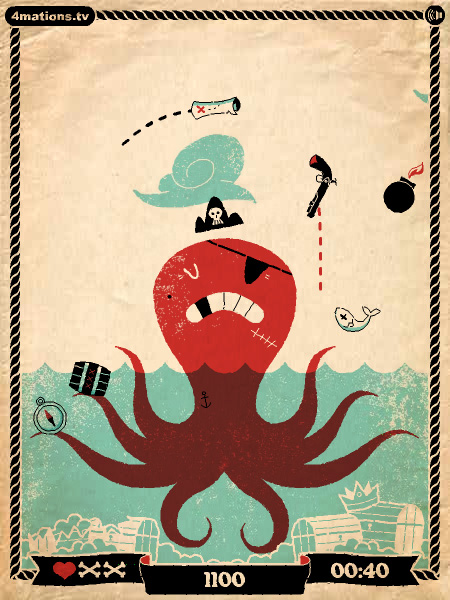
Oh boy do I get excited when illustrators take it upon themselves to make games (e.g. Gesundheit!). In Booty Juggler, you play an octopus trying to protect its pirate gold from falling bombs. I don’t really know how to top that sentence, so I’m going to end the paragraph here.
It’s the brainchild of Robin Davey, a UK-based artist and self-proclaimed gentleman.
(Source: Johnny, via Drawn)
coign of vantage
By: Derek Yu
On: August 15th, 2008
In Bobblebrook’s coign of vantage you assemble 2d pixel icons by rotating a cloud of floating 3d pixels. Which is kind of a Fez-ish idea used in a different context. I like it, although I’m not inclined to play it more than a couple of times. I sorted a little over 50 images and thought that was pretty good, but I’m nowhere near the highscore board.
In fact, the coign of vantage highscore board is so far away from me that I’ve only heard about it in hushed whispers.
(Source: Kieron Gillen, via Rock, Paper, Shotgun)
TIGdb: Entry for coign of vantage
P.S. Wondering what a “”http://www.yourdictionary.com/coign-of-vantage">coign of vantage" is?
AntRush
By: Alehkhs
On: July 27th, 2008

“Wait for Alehkhs’s drop, then send in the Majors,” Phill made the call. From where my Soldiers were, high in the treetops, I saw my ally’s Majors approach the edge of the enemy soil. Great behemoths next to their sisters, the Majors marched on, crushing all opposition with their massive jaws.
As the Majors reached the enemy’s nest, I gave the order to my Soldiers to drop. Falling through the leaves and to the ground below, my forces landed behind enemy lines and immediately began tearing away at their structures, ripping holes into the nest and streaming inside.
The Queen. I have to find the Queen! Where the hell is she!? My Soldiers no longer have the element of surprise and are beginning to take losses.

Eggs! I spy some workers carrying eggs to a nearby hatchery, and I begin a march against their tide, my soldiers slaughtering all that get in their way. Following this river of eggs, I finally come to the Queen, her abdomen swollen from pregnancy. My Soldiers descend upon her, their crushing mandibles slashing her hard exoskeleton.
Finally, our forces execute “her Majesty,” and I watch as her body withers into the soil. The day is ours!
Wanna know more? Continue after the jump.
This is your standard game of AntRush, the premier project by Australian developer Phillip Smith. Inspired by a mix of Will Wright’s old gem SimAnt and the classic games of the Command and Conquer series, AntRush is a casual real-time strategy that pits the tiny denizens of the dirt against each other in massive battles. Players can play against the computer in a 20+ mission Campaign, Challenge missions, or simply an offline skirmish. In addition, players can also participate in online matches with up to 7 other players; whether divided up into teams or as part of a free-for-all. One interesting feature of the Server System is the ability for players to “host a future game,” which will then show up in the server list with the date and time it is planned for. Interested players can “join” this game, letting the host know how many people will be able to make it.
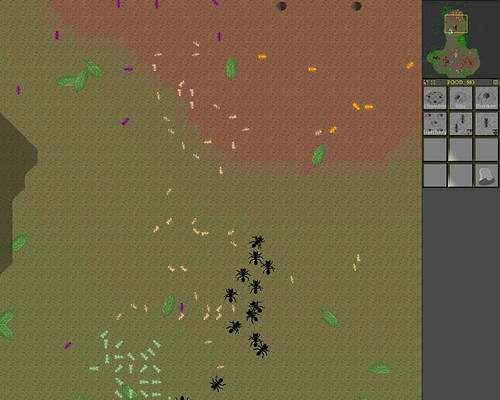
AntRush works like a basic RTS: You construct a base, build (or in this case, birth) units, collect resources, and in time go forth and conquer your enemies. AntRush adapts this general layout and applies it to Ants. You begin with your “factory,” the Queen, and a small handful of units, which might consist of a mix of Workers and Soldiers. The Queen is essentially the flagship of your nest – if she is killed, you are defeated. The Workers construct the nest and collect food, but are next to worthless as a fighting force when it comes to the Soldiers, which are what you will eventually use to defeat your enemies. You can order your Queen to produce more eggs of any given “Caste” of unit, and she will lay the eggs (given that there is enough food; the “money/resource” of the game takes place in the form of fallen leaves). The structures that are shared by all the playable races of the game are simple yet strategically effective: there is the Chamber (allows your Queen to hide under the ground), the Silo (where food is stored), the Bunker (heals ants that rest in it between battle), and the Hatchery (where eggs are hatched).
So, what “races” are there to select from? Smith spent a good part of the planning for the project simply deciding what species of ants would be in the final game. "I researched many of the ants that could be considered “exotic” or “bizarre” or “interesting” and came up with a shortlist," Smith says. “Those on the shortlist, I then came up with logical adaptations of their abilities, nest layouts and castes. Then I compared how one would fair against the other, does this one have far too many bonuses? Etcetera.” In the end, Smith decided on his final four:
 The “Gliding Ant” (Cephalotes atratus) first appears to be a simple ant: The species only has two working castes, a Worker caste and a Soldier Caste. However, what really makes this ant different is in its namesake: it can glide. All ants can travel above the map by climbing up the trunks of trees scattered around the map into the leafy canopy. However the Gliding Ant does not need to climb back down these trunks, but can simply drop immediately from the tree, gliding to the ground directly below. This allows for the Gliding ant to make “surprise attacks” by dropping down on their foes from above. The ant is also covered in thorn-like spikes, which deal damage to any attacker.
The “Gliding Ant” (Cephalotes atratus) first appears to be a simple ant: The species only has two working castes, a Worker caste and a Soldier Caste. However, what really makes this ant different is in its namesake: it can glide. All ants can travel above the map by climbing up the trunks of trees scattered around the map into the leafy canopy. However the Gliding Ant does not need to climb back down these trunks, but can simply drop immediately from the tree, gliding to the ground directly below. This allows for the Gliding ant to make “surprise attacks” by dropping down on their foes from above. The ant is also covered in thorn-like spikes, which deal damage to any attacker.
 The Leaf-Cutter Ant (Atta sexdens) is has the most diversity of all the game’s species in terms of units. This species has 2 types of Workers, as well as 2 types of Soldiers. The larger of the Worker Castes collects the leaves for the colony’s food supply, while the smaller Workers can grow and tend a garden from these leaves which increases food revenue. Because of these gardens, the Leaf-Cutters are perhaps the most “economically secure” race in the game. The fighting units of the Leaf-Cutters are also divided by size; regular sized Soldiers, which will automatically partner up with a worker and guard them, and massive Majors, which are the largest fighting units in the game.
The Leaf-Cutter Ant (Atta sexdens) is has the most diversity of all the game’s species in terms of units. This species has 2 types of Workers, as well as 2 types of Soldiers. The larger of the Worker Castes collects the leaves for the colony’s food supply, while the smaller Workers can grow and tend a garden from these leaves which increases food revenue. Because of these gardens, the Leaf-Cutters are perhaps the most “economically secure” race in the game. The fighting units of the Leaf-Cutters are also divided by size; regular sized Soldiers, which will automatically partner up with a worker and guard them, and massive Majors, which are the largest fighting units in the game.
 The third species of ants is the Slave-Maker Ant (Polyergus breviceps). These ants have no Worker Caste of their own. Instead, these ants have a fierce Soldier Caste, and a small, extremely fast Scout Caste. While these units can perform the tasks of workers, such as collecting food from leaves or constructing your nest, they are not very efficient at it. The solution to this problem is given in their name: the Slave-Make Ant makes slaves. By using their fast Scouts to locate and probe enemy nests, the Slave-Makers can rush in with their Soldiers and steal the eggs of their enemy, taking them back to their own nest and raising them as slaves (doing whatever their caste designates). Also, if a Slave-Maker Queen manages to kill the Queen of another race, all the ants under that Queen become slaves rather than simply dying. Sometimes an army of Slave-Makers can double in size as a result of one daring raid. In addition to taking slaves, Slave-Makers utilize the bodies of fallen ants, collecting them alongside leaves as a source of food. The Slave-Maker Ant is the species for risk-takers.
The third species of ants is the Slave-Maker Ant (Polyergus breviceps). These ants have no Worker Caste of their own. Instead, these ants have a fierce Soldier Caste, and a small, extremely fast Scout Caste. While these units can perform the tasks of workers, such as collecting food from leaves or constructing your nest, they are not very efficient at it. The solution to this problem is given in their name: the Slave-Make Ant makes slaves. By using their fast Scouts to locate and probe enemy nests, the Slave-Makers can rush in with their Soldiers and steal the eggs of their enemy, taking them back to their own nest and raising them as slaves (doing whatever their caste designates). Also, if a Slave-Maker Queen manages to kill the Queen of another race, all the ants under that Queen become slaves rather than simply dying. Sometimes an army of Slave-Makers can double in size as a result of one daring raid. In addition to taking slaves, Slave-Makers utilize the bodies of fallen ants, collecting them alongside leaves as a source of food. The Slave-Maker Ant is the species for risk-takers.
 The final species isn’t actually an Ant. Rather; Smith felt that the title fourth race in the game was deserved by Termites (Reticulitermes). The Termites actually don’t differ from the ants too much, and have the similar structures of Chambers, Silos, and Hatcheries. However, there are several large changes that offer the Termites a distinctly defensive strength. First of all is the Watch Tower, which is a special structure that reveals a large portion of the map surrounding it, allowing the Termites to see incoming enemy forces. Then there is the King. That’s right, besides the Queen, Termites also have a King. A player needs to keep both their Queen and King alive in order to lay eggs, but if you lose one, you might be in luck: one of the units of the Termites is the Anate, which can replace either a fallen Queen or a fallen King, giving the player a second chance (or third, or fourth if they spend the resources). The other units of the Termites are mainly built for defensive purposes. There are Workers and standard Soldiers of course, but then there are the Tunnel Guards, which are fierce fighters, but cannot leave the soil surrounding the Nest, making them stay in the area. The last unit of the Termite army is even more restricted in their movement; the Elite Tunnel Guards rival the Leaf-Cutters’ Majors in size, and are superior to them in strength, but are unable to leave the interior of the Nest unless there is a large hole made for them, which is the result of a destroyed structure. This allows for the Termites to set up interesting traps, as if they position several Elite Guards underground around an unprotected structure, luring the enemy to attack and destroy it, the Elite Tunnel Guards rush out, ambushing the enemy. Once above the ground, these large fighters cannot return to the inside of the Nest.
The final species isn’t actually an Ant. Rather; Smith felt that the title fourth race in the game was deserved by Termites (Reticulitermes). The Termites actually don’t differ from the ants too much, and have the similar structures of Chambers, Silos, and Hatcheries. However, there are several large changes that offer the Termites a distinctly defensive strength. First of all is the Watch Tower, which is a special structure that reveals a large portion of the map surrounding it, allowing the Termites to see incoming enemy forces. Then there is the King. That’s right, besides the Queen, Termites also have a King. A player needs to keep both their Queen and King alive in order to lay eggs, but if you lose one, you might be in luck: one of the units of the Termites is the Anate, which can replace either a fallen Queen or a fallen King, giving the player a second chance (or third, or fourth if they spend the resources). The other units of the Termites are mainly built for defensive purposes. There are Workers and standard Soldiers of course, but then there are the Tunnel Guards, which are fierce fighters, but cannot leave the soil surrounding the Nest, making them stay in the area. The last unit of the Termite army is even more restricted in their movement; the Elite Tunnel Guards rival the Leaf-Cutters’ Majors in size, and are superior to them in strength, but are unable to leave the interior of the Nest unless there is a large hole made for them, which is the result of a destroyed structure. This allows for the Termites to set up interesting traps, as if they position several Elite Guards underground around an unprotected structure, luring the enemy to attack and destroy it, the Elite Tunnel Guards rush out, ambushing the enemy. Once above the ground, these large fighters cannot return to the inside of the Nest.
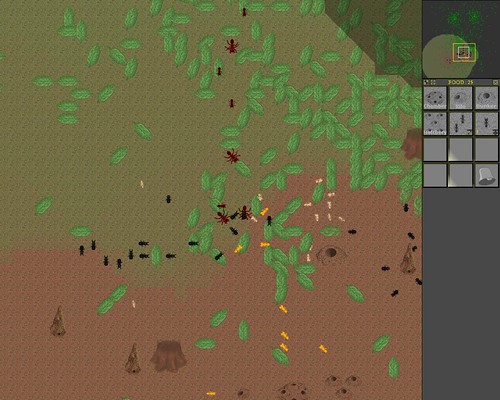
The specialized nature of each of the four Species makes for some rather interesting play online. From desperate rushes by Slave-Makers to thought out and devious ambushes by Termites, the options presented in AntRush allows for deep strategic (yet precisely balanced) play. And while the game its self is complete, Smith is constantly releasing updated versions, which adjust the balance and alter the gameplay slightly but effectively.
What is Smith planning for his next game? “Definitely another AntRush,” he responds, “it turned out to be a great game, and it still has so much potential.” He hopes to make the jump to 3D for that game, and dreams of the gameplay that extra dimension would offer, “I envision seeing ants vertical on a tree trunk, fighting, the losing ant plummeting to the ground.”
AntRush comes in two flavors. A “Free Edition” (note, it isn’t called a “Demo” for a reason), which allows for unlimited play time and access to Online Multiplayer, 6 Campaign Missions, and 3 Challenge Missions. For $10, the player gets the full Campaign and Challenge section. Don’t let the presence of a “Paid” version fool you however; the Free Edition is a fully complete experience.
So get on over to his site, grab your version of this game, and I’ll see you online.


